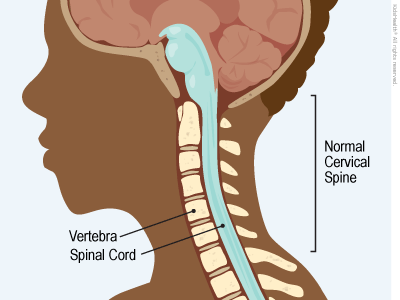Cervical Kyphosis
What Is Cervical Kyphosis?
The cervical spine is the top of the backbone. It normally has a slight curve to it.
Cervical kyphosis (SUR-vih-kull kye-FOE-sis) is when the top of the spine curves in the opposite direction than normal. That can lead to problems.
What Happens in Cervical Kyphosis?
Most cervical kyphosis isn't serious. But if the curve is severe, bones in the spine called vertebrae might pinch the spinal cord. This can damage the spinal cord.

The spinal cord is the body's central communication system. It's a tube of nerves that runs inside the spine. The nerves branch out to every part of the body. They send messages between the brain and the rest of the body.

If damage is very bad, the nerves can't send important signals like telling the lungs to breathe or blood to move around the body.
What Are the Signs & Symptoms of Cervical Kyphosis?
Here are some things parents may notice when a child has cervical kyphosis:
- a C-shaped forward bend in the child's neck
- the child has trouble looking up or turning their head
- the child has neck pain
If the curve is sharp enough to pinch the spinal cord, kids might have these problems:
- pain, tingling, loss of feeling, or weakness
- be unable to move their arms or legs
- trouble peeing or pooping
- accidents because they can't control when they pee or poop (called incontinence)
How Is Cervical Kyphosis Diagnosed?
If you think your child has a neck problem, make an appointment with your pediatrician. The doctor, nurse, or physician assistant will ask about what's going on. They will order tests like X-rays.
If the pediatrician thinks your child needs specialized help, they will send you to a specialist. Specialists who treat kids with kyphosis are:
- neurologists (experts in the nervous system)
- neurosurgeons (doctors who operate on the brain and spinal cord)
- orthopedists (experts in bones, muscles, and joints)
How Is Cervical Kyphosis Treated?
Treatment depends on the child's age and how bad the curve is. The medical team uses several strategies to help children with kyphosis:
Bracing. Children may wear a neck brace to treat cervical kyphosis.
Physical therapy.Physical therapists work with kids to help improve flexibility and posture and reduce pain.
Pain management. If kids have pain, doctors and nurses prescribe medicines and other ways to help manage pain.
Surgery. Kids need surgery when a curve puts pressure on the spinal cord in a way that may cause nerve damage. Kids who also have diseases that make their bones weak or slow to heal may need more than one operation. Halo gravity traction might be a useful technique to help before kids get surgery.
What Causes Cervical Kyphosis?
Kids can get cervical kyphosis in three ways:
1. They are born with it.
This is called congenital cervical kyphosis. No one knows what causes it. Doctors do know that it has nothing to do with anything a mom did when she was pregnant.
2. Something goes wrong in the body.
This is called acquired cervical kyphosis. Lots of different things can cause it, such as:
- injury to the bones of the spine or the ligaments around them
- infection
- tumors
- surgery
- radiation therapy for cancer
3. They have a medical condition that causes them to get kyphosis.
For example:
- skeletal dysplasia
- spina bifida
- osteogenesis imperfect (OI)
- neurofibromatosis type 1
Who Gets Cervical Kyphosis?
Cervical kyphosis isn't common. It can happen to any child, but kids who have it often have another health problem too.
Parents can't stop cervical kyphosis from happening. But they can help kids get the best care.
How Can Parents Help?
It's important to diagnose spine problems early. If kids don't get treatment, some may end up with spinal cord damage that can't be fixed.
Here are tips for avoiding problems:
- See a doctor if your child has trouble with head movements or neck pain. Neck trouble needs to be checked out to be sure it's not something serious.
- Take your child to all medical visits. Even a small curve can get bigger as a child grows. The care team will want to keep watching for possible problems.
- If your child had surgery, ask the care team when you should bring your child for follow-up visits. They will check your child to be sure the kyphosis does not come back.
The care team is a resource — for you and your child. They can answer questions and help your child get the best treatment. Reach out when you have questions or concerns.


